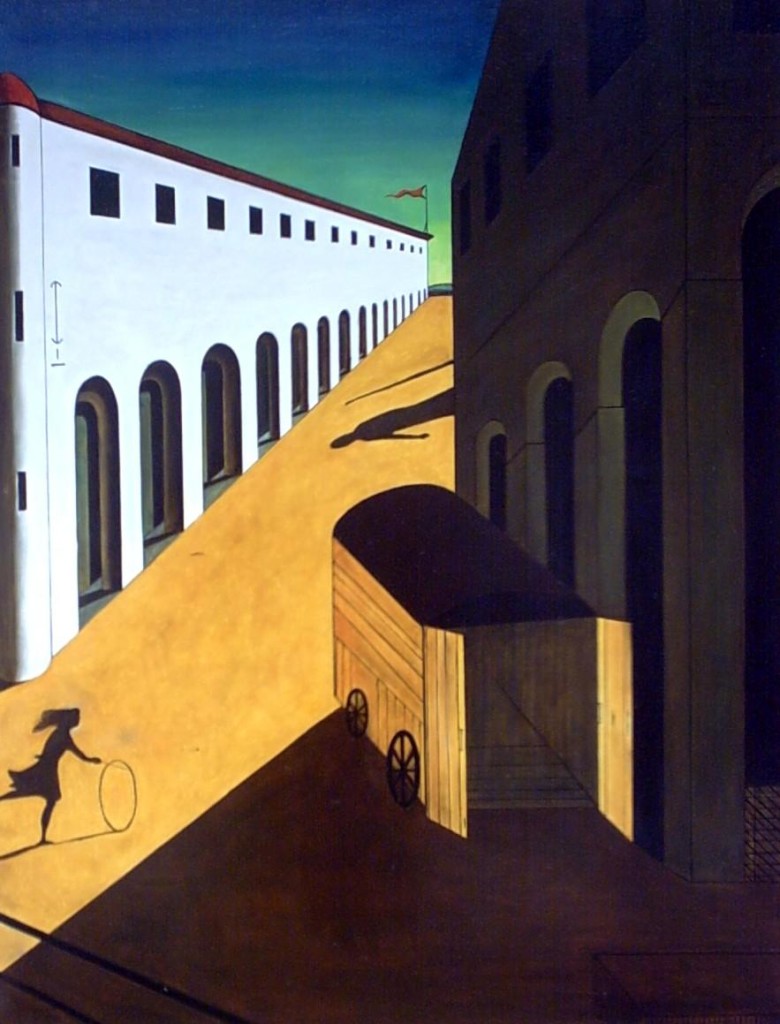Giorgio de Chirico created one of the first of these invented worlds and one of the most enduring. Before the word surrealism was invented he anticipated many of its devices without crossing the line into its later conventions of morbidity and sensationalist shock value. He painted combinations and recombinations of a limited set of motives that, despite the use of repetition between his different paintings, they do remain undiminished in their sense of mystery and melancholy all glazed with an ominous foreboding that is dampened by a serenity that is pervasive and somehow reassuring.
de Chirico’s world contains a unified paradox of being both desolate and intimate, empty but loaded with suggestion, vacuous, yet charged with mysterious presences. It is a world that is never explained and is part of the reason it continues to fascinate through a basculation, a gyration between volatile themes of metaphysics and fatality mingling with destiny, torment and dream.

—de Chirico’s The Arcades Project? The theme of assemblage pervaded art and literature at the beginning of the 20th century. One immediately thinks of avant-garde iterations of the collage, the importance of pastiche, and self-reflexive practices of montage exemplified by Dada and Futurist intervention into mass culture and industry. Surrealist psychological intervention is more relevant to de Chirico and Benjamin, with its focus on memory, dream, nostalgia, and depaysement, perhaps best represented by the “profane illumination” elicited by objet trouve, and the chance encounters of the protagonist in Andre Breton’s Nadja. This second example is consonant with Benjamin’s opening to One Way Street, “The street is named/ Asja Lacis Street/ after her who as an engineer/ cut it through the author.” He associates his own “object” of longing within the topography of the modern city.–click image for source…
The van in Melancholy and Mystery of a Street is empty. Why? In The Anguish of Departure the van doors are closed. What do they hide? What is perplexing is the challenge of rationalizing the presence of the van or the disposition and relationship of any of the objects in a Chirico painting on any kind of basis founded on logic and reason, despite the reality of their existence.

—De Chirico’s iconography became significantly more sexualized in the works beginning in the year 1913, presumably as a result of encountering the poet Apollinaire, who encouraged the artist’s further development of symbols in this direction through more “evident… dialectical opposition” as a translation into painting of the poet’s commonly addressed themes concerning the Ariadne-Dionysus dichotomy and general “polarity between masculine and feminine elements .” This is most clearly seen in The Anguish of Departure through his use of “alternating solids and voids” particularly in the arcade architecture, the vaginal quality of the unknown empty spaces and empty, enclosed boxcar in the foreground, and the phallic nature of the large shadows and towers which consume the space—click image for source…
Call it an irrefutable illogic that accounts for this equilibrium between the disturbing and serene that conveys the power inherent in romantic painting if its emotionalization from the lyrical to the violent can be captured in spirit and palatable in the form of a dreamscape like with Chirico, the unexpected passages of dream in the form of dreamscapes breaking through the more pedestrian course of a work that jettisons the intellectual in favour of the spontaneous.





 COMMENTS
COMMENTS